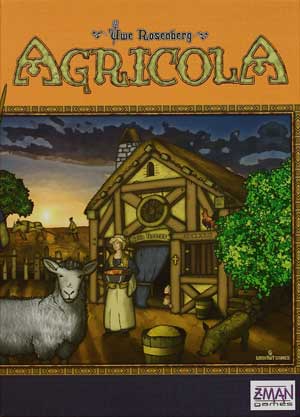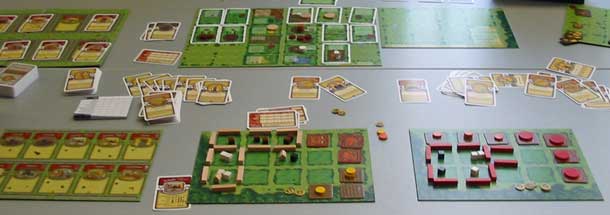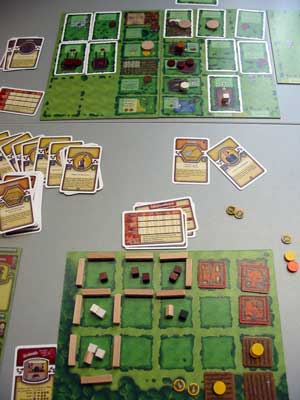Pevans
AgricolaReviewed by Pevans |
 I feel I really ought to give my two pennyworth on the hot game of the moment – though it’s been a very long moment as the game was immediately popular after Spiel ’07, even though it was only available in German. I’m full of respect for those who went to the trouble of pasting up English translations, but that kind of thing is too much work for me these days. The English edition makes Agricola that much more accessible and the game has a whole new, bigger crop of players and admirers. And some people who have played it so intensively that they know the game inside out and back to front. That’s not me by the way: I was treated to a master class by two Americans back in April. A fast-moving three-player game ended with them tied on 52 points each and me on 24. Ouch.
I feel I really ought to give my two pennyworth on the hot game of the moment – though it’s been a very long moment as the game was immediately popular after Spiel ’07, even though it was only available in German. I’m full of respect for those who went to the trouble of pasting up English translations, but that kind of thing is too much work for me these days. The English edition makes Agricola that much more accessible and the game has a whole new, bigger crop of players and admirers. And some people who have played it so intensively that they know the game inside out and back to front. That’s not me by the way: I was treated to a master class by two Americans back in April. A fast-moving three-player game ended with them tied on 52 points each and me on 24. Ouch.
But back to the basics first. The game is about developing a farm and is specifically set in medieval Germany (though I don’t know what difference this makes). Each player has a board representing their farm. The board is divided into squares, which can become fenced pastures or ploughed fields or part of the farmhouse. The game is played over exactly 14 rounds, grouped into six stages. Crucially, there is a harvest at the end of each stage and players need to have enough food for their family at this point. There are four rounds before the first harvest, but only one between the last and penultimate harvests, making it that much harder to get enough food for that last harvest. Of course, by then you will have developed your farm to produce more food – but will have a bigger family, needing more food.
Players start with two family members – big, chunky wooden discs in their colour – one in each room of their house (tiles occupying two of the squares of your farm). This allows players to take two actions each turn, deploying one disc at a time to claim an action – and make sure no-one else can take it. As players get extra discs to play with (expand their family), they can take more actions in a round. One important action is thus expanding your family. However, you need an extra room on your house before you can get that extra disc. This makes building rooms an important action. But to do this you need the raw materials for the room: wood and reeds (for the thatch). So, first you have to collect the raw materials, then take the room building action and then the family expansion action. And you also need to be getting enough food in time for the harvest. You begin to get an idea of how this game works.
The actions are one of the variable elements of the game and part of the way it is tuned for the number of players. The core actions are printed on the boards that go in the middle of the table. Alongside these are spaces for a set of action cards: a different set according to the number of players. Finally, a new action card is added each round. These are the same actions in every game, but are shuffled within the stages. Hence players know what four actions will become available in turns 1-4, for example, but not what order they will appear in.
I’ve already mentioned some of the actions. The most basic of these enable players to gather raw materials – wood, reeds, clay and stone, represented by coloured wooden discs – food (cardboard chits), grain and vegetables (more coloured wooden discs) and animals – sheep, ‘wild’ boar and cattle (coloured wooden cubes). Other actions allow players to fence in squares of their farm as pastures and to build barns, both of which can hold animals – players’ barns and fences are limited to the set in their colour. They can also plough fields (placing field tiles on their farm), sow grain and vegetables (for later harvest) and, if they have an oven, bake bread – which converts grain to food. They can also ‘Renovate’ their house: from wood to clay and from clay to stone.

I brought up ovens above. These are some of the ‘improvements’, a set of cards that provide additional features for players’ farms. The really useful thing about the cooking improvements is that they allow players to turn animals into food. Really useful when it comes to harvest time and you need to feed your family. The other improvements provide other useful abilities and all of them are worth victory points.
Ah yes, victory points: these are totted up at the end of the game and the player with the most points wins, of course. Players get points for the various parts of their farm, but get a minus point if they have none of something. For example, no sheep means -1 point, 1-3 sheep means +1 and 8 or more gets you 4 points. Improvements are worth points as well and may provide a bonus as well. The points scoring system rewards diversity: you need a bit of everything to avoid negative points. Getting lots of something is useful, but there’s a point where you don’t get any more points, regardless of how many you have.
There are several things to be aware of here. First off, you get three points for each member of your family, which is potentially a lot of points and a big inducement to expand your family. A stone house is worth 2 points for each room, which could also be a lot of points. On the down side, every unused square of your farm costs you a point, so it’s well worth filling your board. And the punishment for not feeding your family completely in each harvest is a ‘Begging’ card for each food you’re short. And a Begging card costs you three points at the end of the game. Try not to do what I did in one game: be five food short at the last harvest and cancel out the 15 points my family members were worth. D’oh!
However, I haven’t actually explained what happens in a round. It’s very simple: players take it in turns to deploy one of their discs onto an action and take that action. The more discs (family members) you have, the more actions you can take in a round – another reason to grow your family. However, each action can only be taken once a round. Hence, it can also be important to be first to an action, making the action that makes you first player rather useful. What makes the game complex is deciding which route to take to develop your farm and coping with other players taking the actions you wanted.
Your first priority is, of course, making sure you have enough food for your family come the harvest. You don’t need to have the food in front of you in advance, but you do need to know where it’s coming from. Once you’re comfortable with doing that (and it took me several games to get the hang of it), the next thing to look at is how you develop your farm. In particular, getting the raw materials and the actions to build extra rooms and add family members. This is very important as the family members get you extra actions during the game as well as victory points at the end.
Agricola is a resource management game, a development game and a limited action game. What I particularly like about this game is the way everything fits together. As noted above, as the game progresses players expand their families and use more actions. At the same time, the stages get shorter so players need to use more actions each round. And more actions are available as a new action card is added each turn. The whole thing is so carefully worked out – something that’s characteristic of Uwe Rosenberg’s games, I find.
Now, the question is, why am I smiling? Because I know something you do not know … I am not left-handed! No, what I’ve described so far is the basic, “Family” version of Agricola. Things are about to get complicated.
The other major components of the game are decks of cards. These are divided into “Minor improvements” and “Occupations”. The starting set of action cards are used with the other side up and include actions to play Minor improvements (usually in combination with something else) and Occupations. Like the Major improvements, the minor ones add extra facilities to players’ farms. Typically these give you extra resources or food and are often worth victory points as well. However, they usually cost resources to play and some have a pre-requisite before they can be played. The Occupations mostly improve an action or provide another benefit. They don’t have pre-requisites or cost materials, but the Occupation action usually costs food to use.
 At the start of the game, each player is dealt a hand of seven Occupations and seven Minor improvements. These are your cards for the whole game and it’s unlikely that you will play all of them during the game. What they do is add an extra dimension to your planning and suggest what your strategy should be, to take advantage of your cards. It makes sense to spend time at the beginning of the game, looking at your cards and deciding how best they can be used. In particular, there is often synergy between cards. For example, the “Spindle” and “Butter Churn” both provide extra food for a player who has sheep, while the “Shepherd’s Pipe” allows the player to keep more sheep in their pastures and stables. And the “Master Shepherd” Occupation gets you some sheep.
At the start of the game, each player is dealt a hand of seven Occupations and seven Minor improvements. These are your cards for the whole game and it’s unlikely that you will play all of them during the game. What they do is add an extra dimension to your planning and suggest what your strategy should be, to take advantage of your cards. It makes sense to spend time at the beginning of the game, looking at your cards and deciding how best they can be used. In particular, there is often synergy between cards. For example, the “Spindle” and “Butter Churn” both provide extra food for a player who has sheep, while the “Shepherd’s Pipe” allows the player to keep more sheep in their pastures and stables. And the “Master Shepherd” Occupation gets you some sheep.
The game really comes alive with the addition of the cards. They give players different strengths and opportunities and add depth to the game. They also add to the replay value of the game: everything else may remain the same, but you’ll have a different set of cards each time you play. What’s more, there isn’t just one deck of cards, there are three. The ‘E’ set is the simplest. These cards are straightforward (my examples above are from this deck). The ‘K’ deck contains some more complex cards. Not in their effects, which are generally similar, but in their mechanics. The ‘I’ (Interactive) deck is also more complex, but includes cards that depend on what other people do. For example, the “Punner” allows a player to plough a field when someone else uses a “Plow” card (yes, the game uses American spellings). When setting up a game, you can stick to one specific deck or mix two of them or even all three. How’s that for replay value?
Agricola is a monster of a game. The substantial box is packed with bits – boards, cards, tiles and stacks of wooden pieces. The game is carefully designed so that it works with different numbers of players – including options for solo play. Then there’s the option of the Family game or the standard game with the addition of the Minor improvements and Occupations. And the choice of different decks or combinations of these. All of this works and provides a challenging game that is different every time you play and huge fun. It gets a definite 10/10 on my highly subjective scale.
Agricola was designed by Uwe Rosenberg and published by Lookout Games (in Germany) and Z-Man Games (in the USA). It is a strategy board game for 1-5 players, aged 12+, and takes about 2 hours to play.
This review was first published in To Win Just Once 88, September 2008.